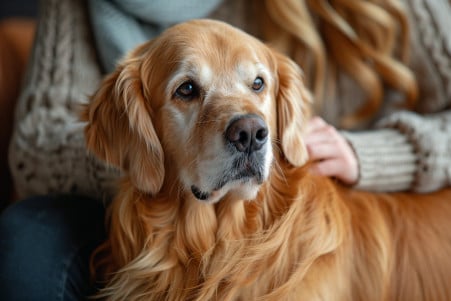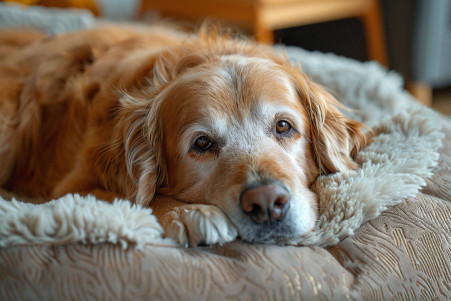How to Strengthen Hind Legs in Older Dogs: Workouts and More
14 May 2024 • Updated 13 May 2024

As dogs get older, it's important to focus on strengthening their hind legs to help them maintain their overall mobility and quality of life. There are a variety of ways to do this, including exercise, supplements, medication, and the use of mobility aids. However, it's important to talk to your vet about the best way to combine these methods to meet your dog's specific needs and limitations.
In this article, we'll take a look at some evidence-based ways to strengthen the hind legs of older dogs so that they can continue to go on walks, run around, and do all of the things that make them happiest. With the help of targeted exercises, supplements, and aids, you can make sure that your loyal companion is able to stay active and happy well into their senior years.
How can I strengthen an older dog's hind legs?
Low-Impact Exercises That Strengthen the Hind Legs
Low-impact exercises are essential for strengthening the hind legs of older dogs without causing too much stress or risk of injury. According to Dr. Barbara Butler, a certified canine rehabilitation therapist, easy exercises that you can do at home can make a big difference in a senior dog's physical and mental health.
One of these exercises is "power posing," which involves doing basic obedience commands on different surfaces to strengthen the abdominal wall, spine, shoulders, and hips. Another exercise is "building up the rear," which involves having your dog put its front paws on a raised surface to shift its weight to the hind legs. Meanwhile, the "leg lift and hold" exercise, which is recommended by Zoetis Petcare, helps with balance by having your dog lift each hind leg for 5-10 seconds while balancing on the other three legs.
To increase flexibility, you can do "cookie stretches," which involve using a treat to coax your dog into gentle spinal stretches and holding the stretch for 5-10 seconds, as outlined by TopDog Health. This same site also explains hip flexor and back stretches that are especially helpful for dogs with arthritis.
These low-impact exercises help to strengthen muscles, increase joint range of motion and support, and can be adjusted in length and difficulty to match your dog's progress. That said, always check with your vet before starting a new exercise program, especially if your dog has any medical conditions. By working these low-impact exercises into your schedule, you can help your senior dog stay active and pain-free.
Hydrotherapy Can Help Improve Mobility
Hydrotherapy is a very effective form of physical therapy for senior dogs who are having trouble getting around. According to the Canine Aquatic Center, hydrotherapy, also known as aquatic therapy, is the use of warm water and special equipment to improve mobility and strength in dogs with disabilities or joint issues.
The water's buoyancy helps to take the weight off of the dog's body, making it easier and less painful for them to move. Because of this, hydrotherapy is a low-impact therapy that can be used on dogs of all ages, including geriatric dogs with issues like arthritis or muscle atrophy, according to the American Kennel Club.
Hydrotherapy can include activities like underwater treadmill walking or swimming, both of which provide resistance to help build strength without putting too much stress on the joints. According to Wag and Cluck, the fact that swimming requires the dog to use their full range of motion can be especially helpful for senior dogs, as it can help reduce pain and build core trunk strength.
It's important to make sure that you're working with a professional who can help tailor your dog's hydrotherapy program to their specific needs and abilities. According to Pawsitively Pure Dog Food, this includes making sure that your dog is wearing a properly fitted flotation device and starting out slowly to make sure that your dog has a safe and productive experience.
When used in conjunction with other therapies, hydrotherapy can help your senior dog improve their mobility, reduce their pain, and continue to live an active, happy life.
Supplements for Joint and Mobility Support
Supplements can be an important part of maintaining joint health and mobility in older dogs. For example, GlycoFlex® Plus - VetriScience states that glucosamine, MSM, green-lipped mussel, and chondroitin have been shown to increase hind leg strength by 41% in just four weeks.
These supplements help by reducing inflammation, lubricating joints, and supporting cartilage repair. 1800petmeds suggests a loading dose period of 4-6 weeks for the best results. Omega-3 fatty acids are also helpful supplements because they can reduce inflammation and provide additional nutritional support for aging joints, according to the American Kennel Club.
When adding supplements to your dog's diet, it's important to make sure you're giving them the right amount and to be aware of any potential side effects. As Our Portland vets point out, you should always talk to your vet before starting your dog on a new supplement to make sure it's safe and tailored to your senior dog's specific needs.
How to Tell If Your Dog Is Having Mobility Issues and When to Use Mobility Aids
As your dog gets older, it's important to know the signs of potential mobility issues. According to the Morris Animal Foundation, some of the most common signs of arthritis or hip dysplasia include limping, difficulty getting up from a sitting or lying position, not wanting to go for walks, and a "bunny hopping" gait when running.
Many of these issues are caused by other problems like osteoarthritis, hip dysplasia, or nerve damage. In fact, Vetnique Labs notes that it's important to know the difference between normal stiffness and pain and a more serious issue that needs to be addressed by a vet, such as sudden lameness, lethargy, or the inability to stand.
If you notice that your dog is having mobility issues, the American Kennel Club suggests that you look into mobility aids like ramps, stairs, or wheelchairs to help your dog stay mobile and comfortable. Catching the problem early and working with your vet to come up with a treatment plan will help ensure that your dog can continue to live a happy and healthy life.
Multimodal Approach: Using Multiple Methods for the Best Outcome
A multimodal approach is necessary to effectively improve and support a senior dog’s back legs. According to Fear Free Happy Homes, this means using a variety of methods such as exercise, supplements, and mobility aids to create a more powerful effect.
For instance, low-impact exercises like walking on an underwater treadmill or swimming can help dogs build strength while minimizing the impact on their joints, according to the American Kennel Club. These exercises can be paired with joint supplements that include glucosamine, chondroitin, and omega-3 fatty acids, which have been shown in clinical studies to help improve a senior dog’s back leg strength, according to GlycoFlex® Plus - VetriScience.
In addition, the PDSA suggests using supportive equipment like ramps or non-slip flooring to help senior dogs maintain their ability to move around and do things for themselves. It’s also important to make sure dogs are regularly checked by a vet so that their treatment plan can be updated based on their progress.
It’s important to note that changes in a senior dog’s mobility can take time, so it’s important for dog owners to be patient and persistent as they use a multimodal approach that’s tailored to their dog’s specific needs and limitations. By using a combination of these methods, you can help your furry friend stay active and comfortable as they age.
Conclusion: How to Help Your Senior Dog With Hind Leg Weakness
It's clear that helping senior dogs build and maintain strength in their hind legs requires a multi-pronged approach that includes low-impact exercises, supplements, hydrotherapy, and mobility aids. However, by working with a veterinarian to create a plan that's tailored to the dog's specific needs and limitations, owners can help their pets stay active and comfortable in their later years.
Regular check-ups and assessments will be necessary to make sure the plan is working and to make any necessary adjustments. With the right care, patience, and a willingness to be proactive, owners can help their senior dogs continue to enjoy the activities and experiences that make them happy while also ensuring they get the support they need.


